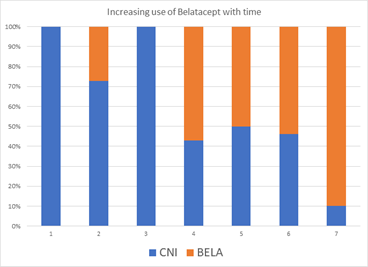Post Transplant Virologic Outcomes in DCD Kidney Transplant Recipients Treated with Thymoglobulin Induction Immunosuppression and Maintenance Belatacept vs Calcineurin Inhibitor Therapy
T. Engebretsen1, M. Kueht1, A. Lea2, M. Mujtaba3
1Abdominal Transplant Surgery, University of Texas Medical Branch, Galveston, TX, 2Infectious Disease, University of Texas Medical Branch, Galveston, TX, 3Nephrology, University of Texas Medical Branch, Galveston, TX
Meeting: 2022 American Transplant Congress
Abstract number: 1354
Keywords: Calcineurin, Circulatory Death, Epstein-Barr virus (EBV), Kidney transplantation
Topic: Clinical Science » Infection Disease » 26 - Kidney: Polyoma
Session Information
Session Time: 7:00pm-8:00pm
 Presentation Time: 7:00pm-8:00pm
Presentation Time: 7:00pm-8:00pm
Location: Hynes Halls C & D
*Purpose: Belatacept is an inhibitor of the T-Cell costimulatory pathway that can be used in recipients of Donation after Circulatory Death (DCD) where the intended recipients are seropositive for EBV. Currently, data is limited on the virologic consequences of belatacept maintenance immunosuppression in comparison to calcineurin inhibitor (CNI) maintenance regimens. This single center retrospective review compared outcomes of EBV, CMV, and BK viremia post DCD kidney transplantation.
*Methods: 80 Patients underwent deceased donor renal allograft transplantation from DCD from 2014 through 2021 this single center retrospective review. All patients were given Thymoglobulin for induction immunosuppression. For maintenance immunosuppression, patients were categorized into 2 groups: de novo belatacept or CNI. There was a noted increase in use of belatacept over time and patients with DGF preferentially received belatacept. Primary endpoint included BK viremia, EBV Viremia, and/or CMV Viremia post transplant.
*Results: The belatacept group (complete CNI avoidance) included 36 patients (48.4 ± 12.4 years, 39% female). The CNI group included 44 patients (51 ± 13.3 years, 45% female). Thymoglobulin was utilized for induction immunosuppression in all patients. In the belatacept group, 6 patients developed CMV Viremia (17%), 2 patients with EBV Viremia (6%), and 6 patients developed BK Viremia (17%). Composite viremia was 14 patients (39%) in the belatacept group. In comparison, the CNI group 3 patients experienced CMV Viremia (7%), no cases of EBV Viremia, and 7 patients with BK Viremia (16%). Composite viremia was 10 patients (23%).
*Conclusions: There was no statistically significant difference between the rates of CMV, EBV, BK or Composite Viremia between the belatacept and CNI Groups. Future studies are warranted given the retrospective study design and small sample size.
To cite this abstract in AMA style:
Engebretsen T, Kueht M, Lea A, Mujtaba M. Post Transplant Virologic Outcomes in DCD Kidney Transplant Recipients Treated with Thymoglobulin Induction Immunosuppression and Maintenance Belatacept vs Calcineurin Inhibitor Therapy [abstract]. Am J Transplant. 2022; 22 (suppl 3). https://atcmeetingabstracts.com/abstract/post-transplant-virologic-outcomes-in-dcd-kidney-transplant-recipients-treated-with-thymoglobulin-induction-immunosuppression-and-maintenance-belatacept-vs-calcineurin-inhibitor-therapy/. Accessed December 21, 2025.« Back to 2022 American Transplant Congress

